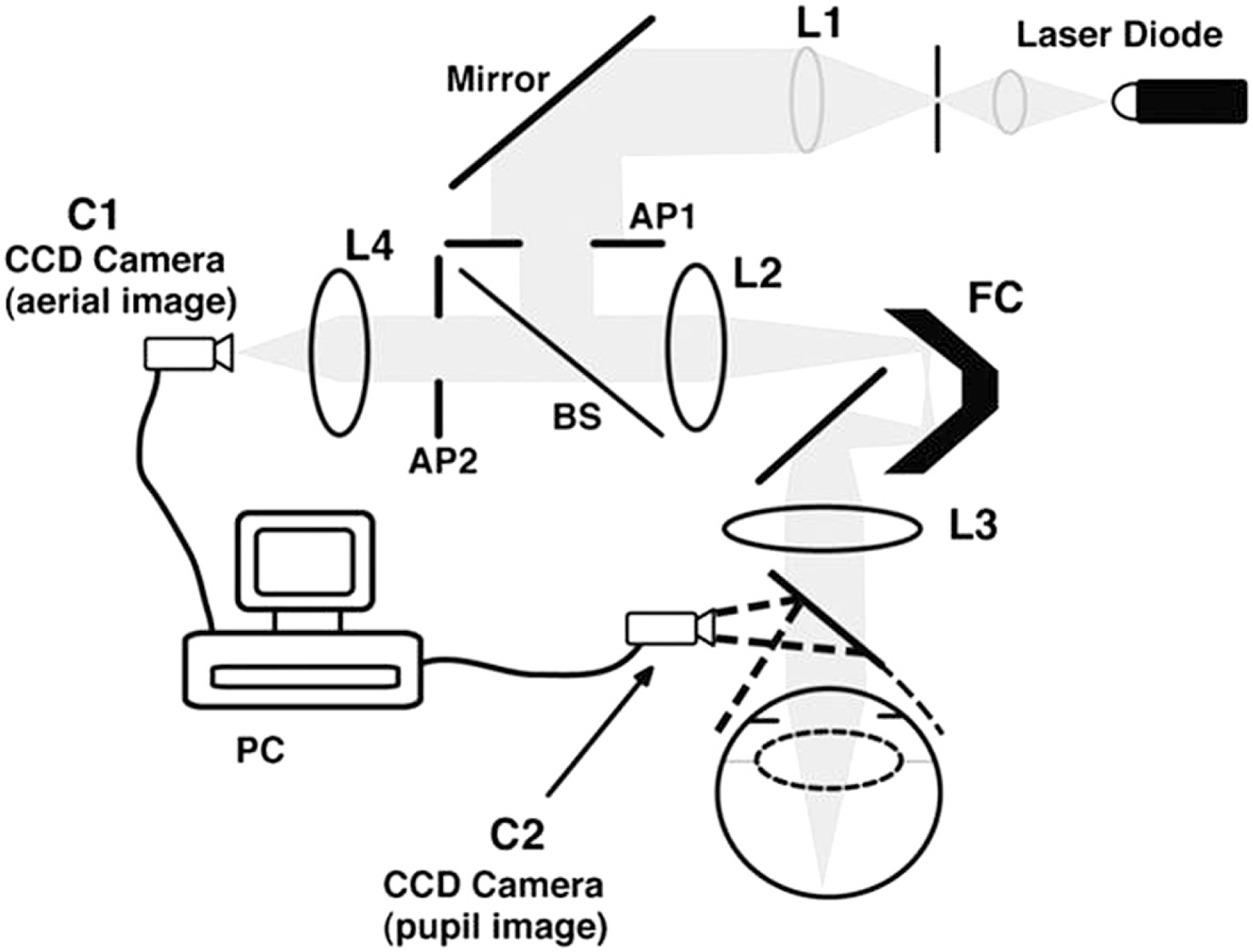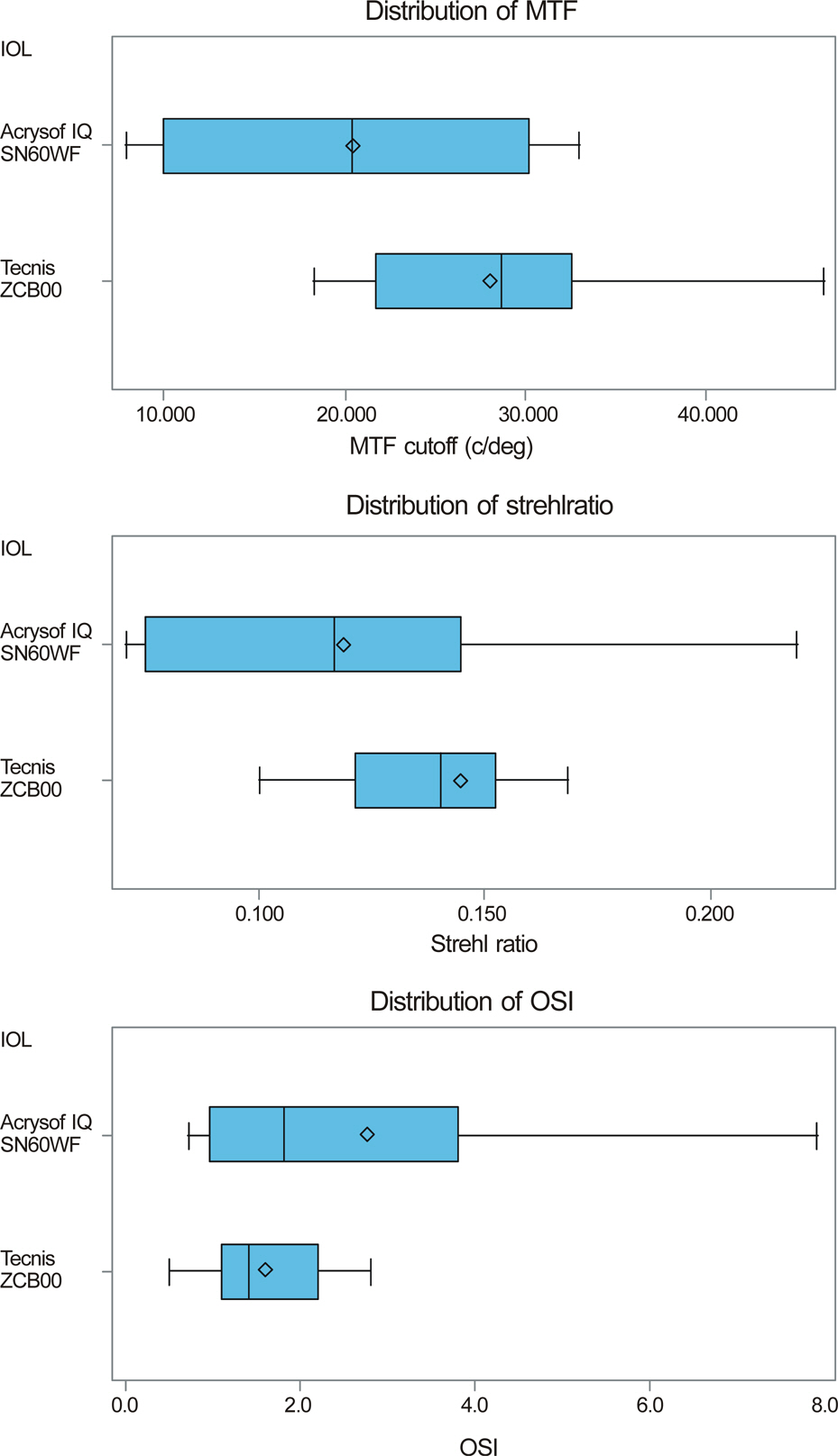J Korean Ophthalmol Soc.
2013 Dec;54(12):1818-1823.
Comparison of Optical Quality Between Two Intraocular Lenses Using Double-Pass Based Optical Quality Analysis System
- Affiliations
-
- 1The Institute of Vision Research, Department of Ophthalmology, Yonsei University College of Medicine, Seoul, Korea.
- 2Siloam Eye Hospital, Seoul, Korea. 24mini@naver.com
Abstract
- PURPOSE
To compare postoperative optical qualities between two types of 1-piece aspheric intraocular lenses using the double-pass technique.
METHODS
Uncorrected visual acuity (UCVA), best corrected visual acuity (BCVA), and spherical equivalent were evaluated in the subject groups; the first which included 25 eyes implanted with Tecnis(R) ZCB00 and the second which included 16 eyes implanted with Acrysof(R) IQ SN60WF. In addition, modulation transfer function (MTF) cut-off, Strehl ratio, and objective scattering index (OSI) were measured 6 months after cataract surgery in the 2 subject groups using Optical Quality Analysis System (OQAS, Visiometrics S.L., Terrasa, Barcelona, Spain) which is based on the double-pass technique.
RESULTS
There were no significant differences in the spherical equivalent, UCVA, BCVA, and OSI between the 2 groups. However, both the MTF cut-off, and Strehl ratio showed statistically significant differences. The MTF cut-off (28.0 +/- 7.79 vs. 20.4 +/- 9.51 c/deg, p = 0.025) and Strehl ratio (0.14 +/- 0.04 vs. 0.12 +/- 0.05, p = 0.042) were higher in the Tecnis(R) ZCB00-implanted group.
CONCLUSIONS
The difference in characteristics of intraocular lenses subtly affects the vision quality as measured by values such as MTF cut-off and Strehl ratio after cataract surgery. OQAS based on the double-pass technique is considered useful in more objective estimates of the real retinal image quality after cataract surgery which is difficult to explain simply by measuring visual acuity.
Keyword
Figure
Reference
-
References
1. Werner L, Olson RJ, Mamalis N. New technology IOL optics. Ophthalmol Clin North Am. 2006; 19:469–83.2. Tzelikis PF, Akaishi L, Trindade FC, Boteon JE. Spherical aberra-tion and contrast sensitivity in eyes implanted with aspheric and spherical intraocular lenses: a comparative study. Am J Ophthalmology. 2008; 145:827–33.
Article3. Kim SW, Ahn H, Kim EK, Kim TI. Comparison of higher order aberrations in eyes with aspherical or spherical intraocular lenses. Eye (Lond). 2008; 22:1493–8.
Article4. Bae HW, Kim EK, Kim TI. Spherical aberration, contrast sensi-tivity and depth of focus with three aspherical intraocular lenses. J Korean Ophthalmol Soc. 2009; 50:1639–44.
Article5. Park SJ, Wee WR, Lee JH, Kim MK. Comparison of wavescan aberrometer refraction to subjective manifest refraction and autorefractor. J Korean Ophthalmol Soc. 2009; 50:684–90.
Article6. Vilaseca M, Arjona M, Pujol J. . Optical quality of foldable monofocal intraocular lenses before and after injection: Comparative evaluation using a double-pass system. J Cataract Refract Surg. 2009; 35:1415–23.7. Eom Y, Yoo E, Kang SY. . Change in efficiency of aspheric in-traocular lenses based on pupil diameter. Am J Ophthalmol. 2013; 155:492–8.e2.
Article8. Díaz-Doutón F, Benito A, Pujol J. . Comparison of the retinal image quality with a Hartmann-Shack wavefront sensor and a double-pass instrument. Invest Ophthalmol Vis Sci. 2006; 47:1710–6.9. Norrby NE, Grossman LW, Geraghty EP. . Determining the imaging quality of intraocular lenses. J Cataract Refract Surg. 1998; 24:703–14.
Article10. Saad A, Saab M, Gatinel D. Repeatability of measurements with a double-pass system. J Cataract Refract Sur. 2010; 36:28–33.
Article11. Vilaseca M, Padilla A, Pujol J. . Optical quality one month af-ter verisyse and Veriflex phakic IOL implantation and Zeiss MEL 80 LASIK for myopia from 5.00 to 16.50 diopters. J Refract Surg. 2009; 25:689–98.
Article12. Artal P. Understanding aberrations by using double-pass techniques. J Refract Surg. 2000; 16:S560–2.
Article13. Artal P, Benito A, Pérez GM. . An objective scatter index based on double-pass retinal images of a point source to classify cataracts. PloS one. 2011; 6:e16823.
Article14. Lee J, Kim JH, Kim EK, Kim TI. Comparative study of clinical outcomes between 2 types of 3-piece aspheric intraocular lenses. J Korean Ophthalmol Soc. 2012; 53:43–8.
Article15. Beiko GH, Haigis W, Steinmueller A. Distribution of corneal spherical aberration in a comprehensive ophthalmology practice and whether keratometry can predict aberration values. J Cataract Refract Surg. 2007; 33:848–58.
Article16. Chantra S, Pachimkul P, Naripthaphan P. Wavefront and ocular spherical aberration after implantation of different types of asphe-ric intraocular lenses based on corneal spherical aberration. J Med Assoc Thai. 2011; 94(Suppl 2):S71–5.17. Lee KM, Park SH, Joo CK. Comparison of clinical outcomes with three different aspheric intraocular lenses. Acta Ophthalmol. 2011; 89:40–6.
Article18. Ferrer-Blasco T. Effect of partial and full correction of corneal spherical aberration on visual acuity and contrast sensitivity. J Cataract Refract Surg. 2009; 35:949–51.
Article19. Salvatore S, Lupo S, Nebbioso M. . New insight into visual function with aspherical intraocular lenses (IOLs): Tecnis ZCB00 and Acrysof SN60WF. Int Ophthalmol. 2011; 31:417–9.
Article20. Jeong JH, Kim MK, Wee WR, Lee JH. Comparison of optical performances in eyes implanted with aspheric and spherical intra-ocular lenses after cataract surgery. J Korean Ophthalmol Soc. 2010; 51:1445–52.
Article21. Alió JL, Schimchak P, Montés-Micó R, Galal A. Retinal image quality after microincision intraocular lens implantation. J Cataract Refract Surg. 2005; 31:1557–60.
Article22. Kamlesh Dadeya S, Kaushik S. Contrast sensitivity and depth of focus with aspheric multifocal versus conventional monofocal in-traocular lens. Can J Ophthalmol. 2001; 36:197–201.
Article
- Full Text Links
- Actions
-
Cited
- CITED
-
- Close
- Share
- Similar articles
-
- The Recovery of Optical Quality after Laser Vision Correction
- Evaluation of Optical Quality Parameters and Ocular Aberrations in Multifocal Intraocular Lens Implanted Eyes
- Measuring Defocus Curves of Monofocal, Multifocal and Extended Depth-of-focus Intraocular Lenses Using Optical Bench Test
- Objective Evaluation of Changes in Optical Quality after Pterygium Excision
- Visual Performance and Optical Quality after Implantation of a New Generation Monofocal Intraocular Lens



